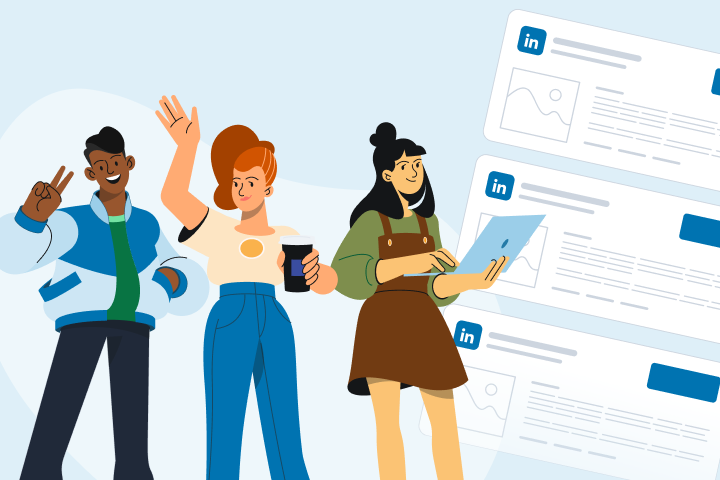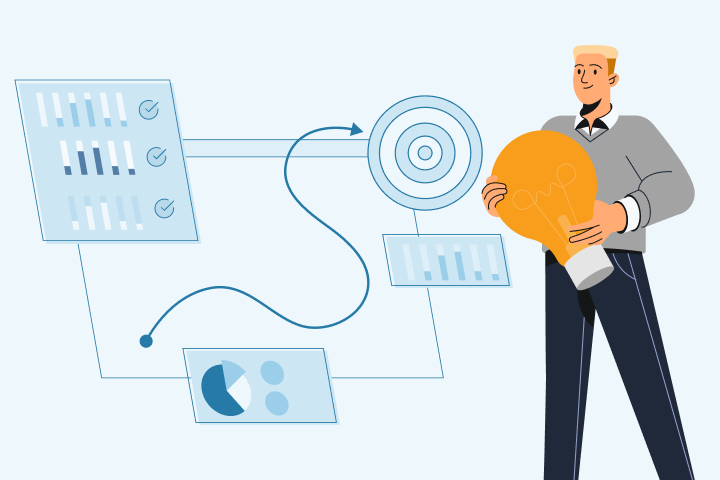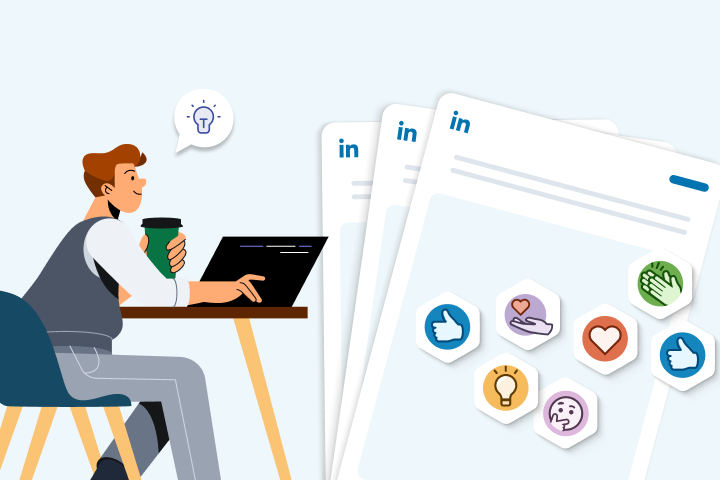The Benefits of Employee Advocacy Programs
Expanding your brand’s reach is key to company growth, and an employee advocacy program is one tactic many businesses are using to promote their brands.
Employee advocacy programs empower employees to act as brand ambassadors. By promoting the company through their own social media platforms, employees help the brand by enhancing visibility, expanding outreach, and building trust.
If you don’t already have one place, it’s never too late to start an employee advocacy program.
In this article, we’re going to break down what is employee advocacy, explain how your company can tap into employee networks via an employee advocacy program, and provide examples of how employee advocacy can positively impact your brand’s visibility and trust.
Let’s get started.
What Is an Employee Advocacy Program?
An employee advocacy program utilizes your employees’ social media reach by encouraging them to share positive brand messages across their social networks.
Brand messaging can include:
- Endorsing and promoting the company's brand.
- Sharing positive work-related experiences.
- Vouching for their company's products or services.
Essentially, an employee advocacy program is the modern-day version of word-of-mouth marketing fueled by the power of social media. The employee advocate role is crucial because it makes the marketing appear more authentic and genuine to your target audience.
By making your employees in-house brand ambassadors, your company can:
- Boost brand awareness.
- Improve customer relations.
- Drive business growth through increased lead generation.
- Attract potential new employees and customers.
- Lower your marketing costs since you’ll be paying less for digital advertising space.
Benefits of an Employee Advocacy Program
A strong employee advocacy program can positively transform a company’s internal and external branding. However, if you’re still on the fence, consider these employee advocacy statistics: 73% of social media managers report that employee advocacy doubles the brand’s social media engagement, 71% of firms experienced increased visibility, and 65% experienced increased brand recognition.
These statistics show how implementing an employee advocacy program can benefit your company. Here are six additional benefits of employee advocacy program:
1. Better Employee Engagement
Employee advocacy produces better employee engagement not only internally but externally, too. 73% of social media managers report that employee advocacy doubles their brands’ social media engagement.
2. Building Brand Loyalty
A robust employee advocacy program will also help build brand loyalty. Here’s how: when your employees create and share quality content, it’s viewed as more authentic, which builds trust. Over time, your audience will equate that trust with brand loyalty, ultimately going to your brand for answers, products, or services.
3. Brand Awareness
A strong employee advocacy program can help boost your brand awareness. If you’re still on the fence, consider these employee advocacy statistics: 71% of firms experienced increased visibility, and 65% experienced increased brand recognition.
4. Increased Social Presence
Transforming your employees into brand advocates will significantly increase your social presence. As they share posts, comment, and respond, your employees will not only grow your brand recognition and trust, but your employees will be viewed as authentic thought leaders in their industry.
5. Attracting Top Talent
Employee advocacy benefits also extend beyond increasing brand recognition. An employee advocacy program can help foster a collaborative, inclusive culture where employees feel valued and heard. This can heighten employee morale, which can translate into better productivity, lower staff turnover, and attract new talent.
To attract the best new talent, you also need to have strong employer branding.
Employer Branding
Employer branding is how you market your company online (and social media) as a great place to work. Having strong employer branding is important: 79% of job seekers use social media for their job search and 84% of organizations use social platforms as a recruiting tool.
To cut through the competitive online job market, and recruit the best talent, you’ll need to develop an employer branding strategy.
Now that we know what employee advocacy is, and its benefits, let’s dive into employee advocacy strategy including tools, platforms, and examples.
Employee Advocacy Strategy
Employees are a company's most valuable asset. However, too often, companies underutilize the potential of employee networks. One way to tap into this valuable resource is with an employee advocacy strategy.
An employee advocacy strategy is a technique where employees share and engage with branded messages with their professional social networks to increase brand reach. The advocacy can be as simple as chatting with a friend about company culture, or as extensive as promoting company content (e.g., new product or case study) on their LinkedIn account.
To launch a successful employee advocacy strategy, you need to have employee advocacy guidelines in place. These guidelines will help you determine your objectives (e.g. increasing traffic, generating leads), set policies and procedures to protect the company's online reputation, and choose how to motivate your staff to participate.
Employee Advocacy Tools
Using an employee advocacy platform is ideal for companies that are concerned about branding consistency, protecting their online reputation, and allocating resources to deploy their advocacy program.
Choosing an employee advocacy tool like GaggleAMP can automate, streamline, and amplify the process for you. Here’s how the platform works.
Step 1: Select an Engagement Activity
Inside GaggleAMP, select an engagement activity (like, comment, share, etc.) for the social media platform of your choice (LinkedIn, X, Facebook, Pinterest, Instagram, etc.).
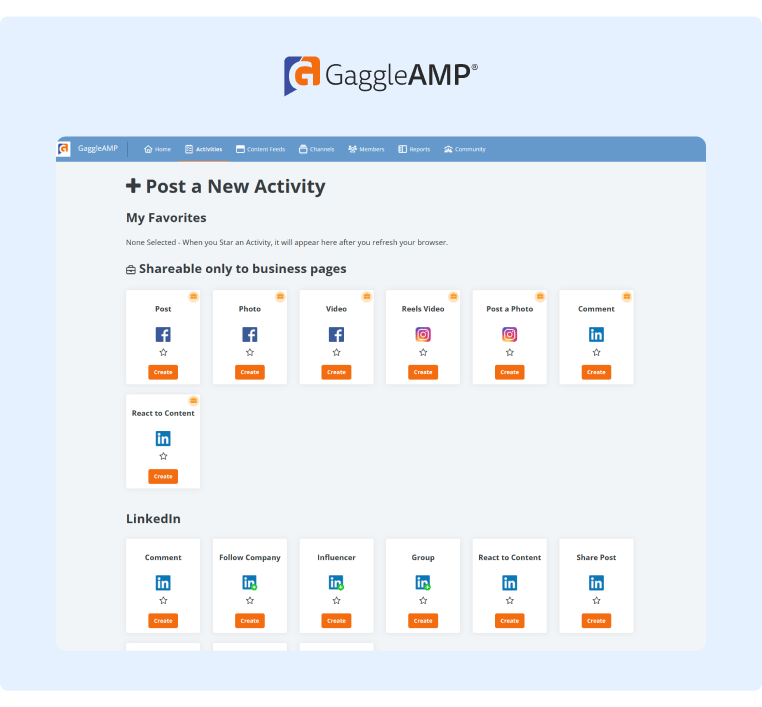
Next, fill out the new activity form with a specific request, like a link to the exact post that you want them to engage with. You can even pre-write the text you want your members to share.
If you’re worried about creating unique and authentic content for multiple team members, you can supercharge your employee advocacy efforts with GaggleAMP’s AI-powered paraphrase tool.
You can also add an expiration date so the activity disappears from the employee’s activity list after that date. This keeps their list short and up-to-date.
Step 2: Assign the Engagement Activity
GaggleAMP makes it easy to assign specific engagement activities to specific groups like marketing or sales teams, or even an individual like an executive. When you assign employee engagement activities, team members receive a notification via email, Slack, or Microsoft Teams.
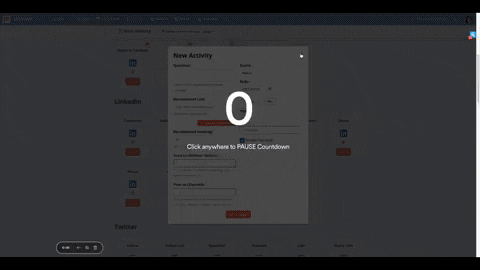
Assigning the engagement activity ensures the right group will share the right content on social media.
Step 3: Employees Complete the Engagement Activity
After team members click on the notification that was sent, they are taken to their own personal Gaggle dashboard. Here, the employee will see a list of engagement activities along with any instructions that you added.
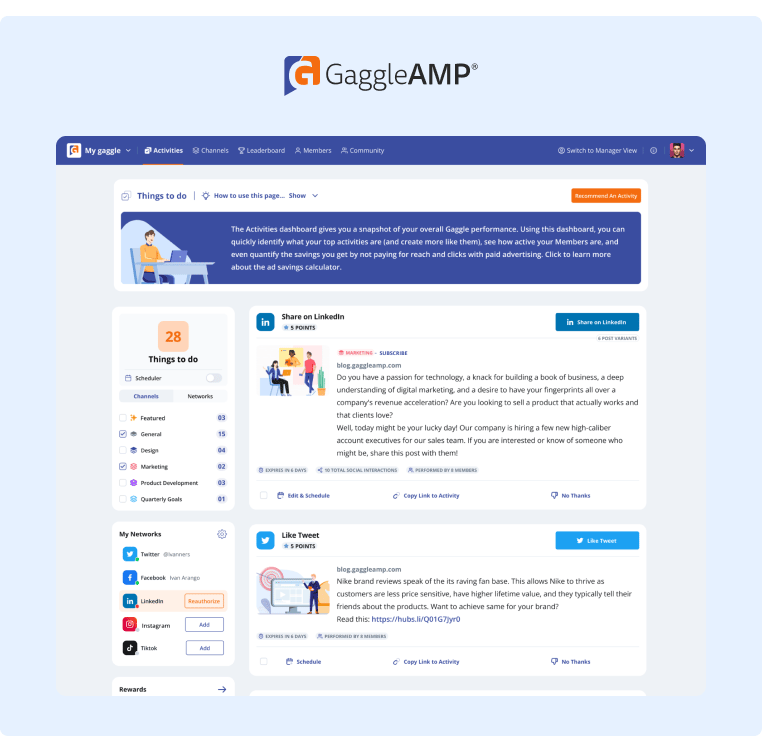
Most engagement activities can be completed inside the dashboard and scheduled to be published at a later date/time. Scheduling content in advance enables team members to complete their engagement activities in one sitting, so they only have to block out a few minutes for employee advocacy each week.
Step 4: Track and Measure Employee Advocacy Efforts
Tracking the ROI of employee advocacy can be challenging. With GaggleAMP's analytics dashboard, you'll get key performance indicators (KPIs) to help track and measure your employee advocacy efforts.
Our robust analytics dashboard offers metrics such as:
- Number of social interactions, shares, and clicks.
- Total reach and unique activities created.
- Most active members.
- Employee earned media value (EEMV).
Step 5: Reward Employees for Their Participation
Boosting employee engagement is critical for the success of your advocacy program. Introducing elements of gamification is an effective way to enhance engagement. GaggleAMP tracks each employee’s engagement activity and ranks them in an internal leaderboard. This enables you to recognize and reward your most engaged employees.
It also makes it easy to see which employees aren’t engaged so you can reach out and provide additional support (if needed).
Now that you have a solid employee advocacy strategy in place and an employee advocacy tool selected, it’s time to explore some employee advocacy program examples.
Employee Advocacy Program Examples
Brands like Guardian, Sodexo, and Archer are just a few who have built their successful employee advocacy programs on GaggleAMP.
Here are a couple of our favorite employee advocacy program examples:
1. Archer
Archer’s employee advocacy program helps them increase brand awareness through social media platforms like LinkedIn. In fact, many brands harness the power of employee advocacy on LinkedIn. The professional network is ideal for tapping into employees’ existing networks, expanding the reach of a company's online presence. LinkedIn is an ideal platform where brand ambassadors can amplify the company’s mission, values, and offerings.
If you’re looking for an employee advocacy LinkedIn example for your own campaign, Archer has plenty of inspiration. For example, the company hosted Bloomberg at Archer’s Headquarters for their “Chief Future Officer” series to give an inside look into Archer’s business and how they’re planning to bring their electric air taxis to market.
The company shared this update on their LinkedIn page, and it was reposted 20 times so far, with several reposts coming from Archer’s own employees including CFO Mark Mesler.
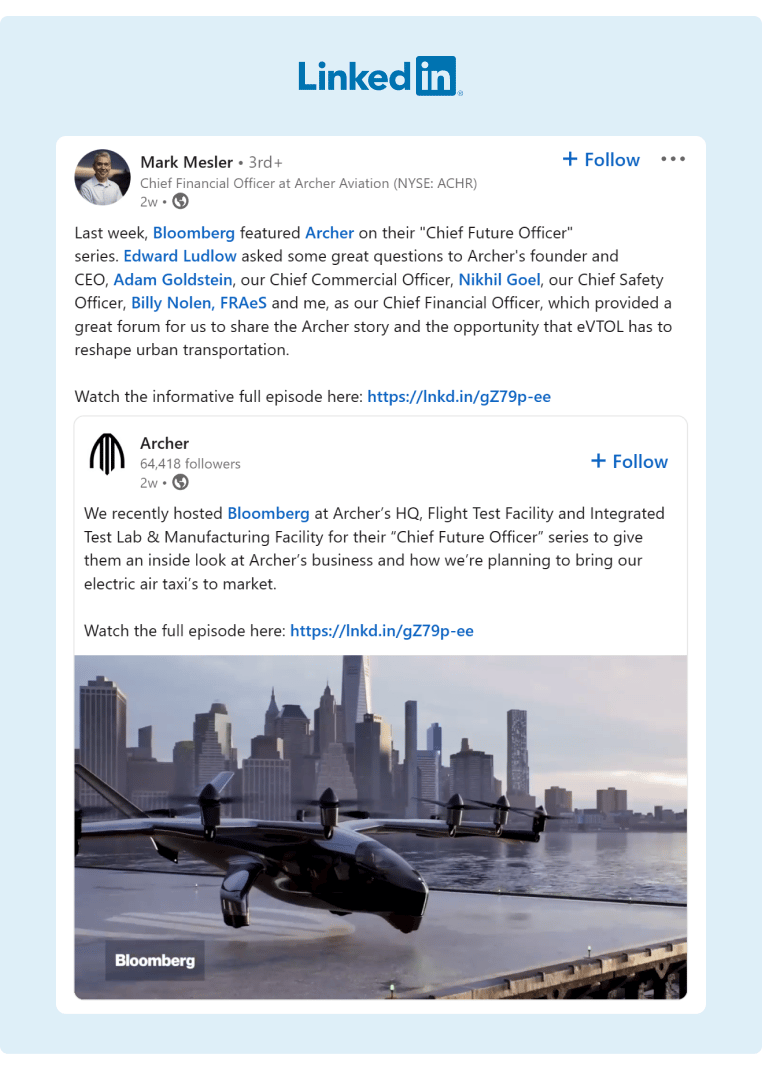
Source: Mark Mesler
2. Starbucks
Starbucks is a classic example of a brand with excellent employee advocacy. Starbucks employees, referred to as partners, are regularly featured on its social sites. Their engaging content showcases not only their love for the brand, but for their jobs and customers, as well.
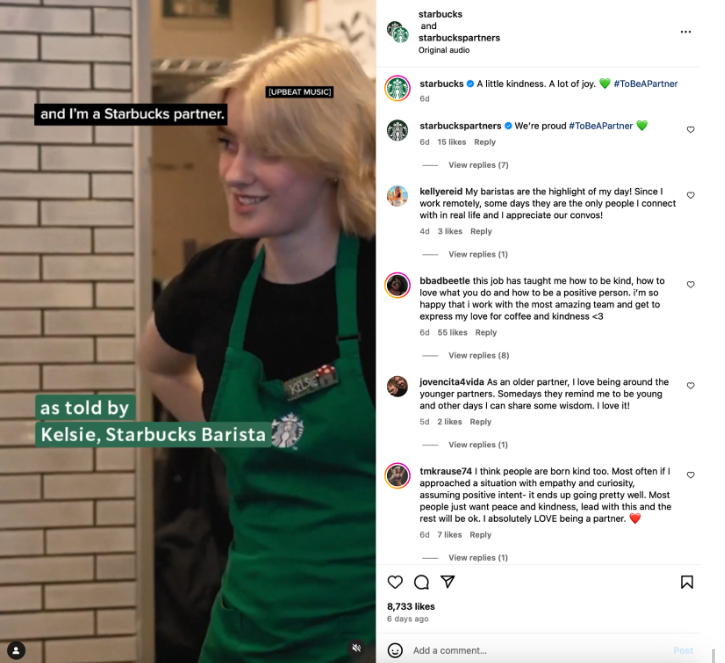
Source: Starbucks
In addition to employee advocacy, don’t forget to take advantage of company advocacy, too. Starbucks is also a pro at this form of advocacy.
Advocacy marketing gets your existing customers to share their positive experiences with your company. This user-generated content can have a strong positive impact on your brand recognition. And your employees can repost it to their own social networks, furthering your brand’s reach.
Think about how many times you’ve shared a Starbucks drink on Instagram. It’s probably a lot, and that’s what Starbucks is banking on.
Final Thoughts
Successful employee advocacy programs don’t happen overnight; they require strategic planning. But once an employee advocacy solution is implemented, companies set themselves up to reap the rewards of increased employee engagement, boosted brand awareness, increased lead generation, and more.
Ready to empower your employees to drive actionable results that strengthen your social media presence and digital marketing footprint? GaggleAMP’s employee advocacy platform can help you achieve those goals. Schedule your free demo today.



